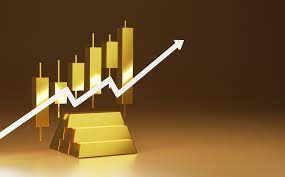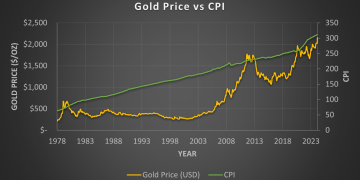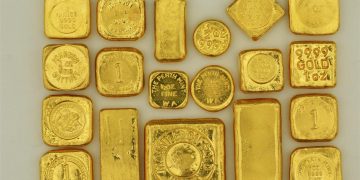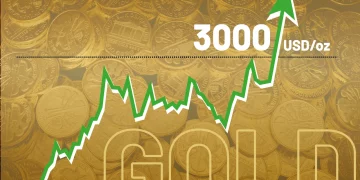Gold has always been a key asset for investors looking to protect and grow their wealth. It is widely regarded as a safe-haven asset, meaning that during times of financial instability or geopolitical turmoil, investors flock to gold to preserve their capital. However, even though gold is often associated with long-term stability, its price can fluctuate significantly in both the short and long term. Understanding how to capitalize on these fluctuations can lead to profitable gold investments. This article provides expert tips on how to use gold’s price movements to your advantage, whether you are looking for short-term gains or long-term security.
Tips for Capitalizing on Short-Term Gold Price Movements
While gold is often seen as a long-term investment, its price is far from static. In fact, gold’s price can swing dramatically in the short term due to various factors, including changes in global economic conditions, geopolitical events, and shifts in investor sentiment. For those with a keen eye and a strategy in place, these short-term fluctuations can present profitable opportunities.
1. Timing Your Entry and Exit Points
The key to short-term trading in gold lies in timing. To capitalize on gold’s price swings, investors need to develop the ability to time their market entry and exit points. Historically, gold prices tend to rise during times of economic uncertainty or geopolitical instability. For example, during market crashes or economic recessions, gold often outperforms other assets. Conversely, when markets stabilize, gold prices may experience a dip.
By closely monitoring news and financial events, you can identify trends and anticipate potential price movements. For instance, if inflation is rising or if there is an increase in geopolitical tensions, it may signal a potential rise in gold prices. Entering the market at the right time and selling when gold reaches a peak can help maximize profits.
2. Take Advantage of Price Volatility
Gold’s price volatility is a defining feature of the market. While this can be nerve-wracking for long-term investors, short-term traders can use this volatility to their advantage. Short-term price swings can be triggered by various factors, such as central bank policies, interest rate changes, and currency movements. By tracking these factors closely, investors can take advantage of quick price fluctuations by buying low and selling high.
Using technical analysis, such as candlestick patterns and moving averages, can also help identify potential entry points during periods of price volatility. By applying these methods, investors can make informed decisions and potentially capitalize on smaller, but still profitable, price changes.
3. Consider Using Gold ETFs for Short-Term Trading
Gold exchange-traded funds (ETFs) offer a convenient and flexible way to trade gold without needing to buy physical gold. ETFs track the price of gold and allow investors to buy and sell shares of the fund on the stock exchange, just like any other stock. This makes them an ideal choice for those looking to capitalize on short-term price movements without the need for the complexities of buying and storing physical gold.
For example, the SPDR Gold Shares ETF (GLD) is one of the most popular gold ETFs, reflecting changes in the gold price. ETFs like these offer an easy way to gain exposure to gold’s price fluctuations and can be bought or sold at any time during market hours.
Understanding Long-Term vs Short-Term Gold Price Trends
Gold has different uses and appeals depending on the investment horizon. While short-term trading focuses on capitalizing on immediate price movements, long-term gold investing is about preserving wealth over an extended period.
Long-Term Gold Investment
Historically, gold has been a strong performer as a store of value, especially during times of economic instability and inflation. In the long term, gold tends to appreciate, primarily due to inflationary pressures and the finite supply of gold. Unlike fiat currencies, which can be printed at will by governments, the supply of gold is limited, which helps to protect its purchasing power over time.
In periods of economic expansion, gold prices may not experience the same dramatic increases as in times of inflation or financial crises. However, over a multi-decade horizon, gold’s ability to preserve wealth and act as a hedge against currency devaluation remains strong. Long-term gold investors are less concerned with short-term fluctuations and more focused on gold’s ability to maintain value over time.
Short-Term Gold Investment
Short-term gold investing, on the other hand, involves capitalizing on price fluctuations within a shorter time frame, typically ranging from days to months. This type of investing requires careful monitoring of market conditions, news, and events that can affect gold prices. In recent years, short-term movements in gold have been influenced by factors such as changes in U.S. interest rates, economic reports, and geopolitical developments.
For those with a shorter investment horizon, the goal is to buy gold at a low price and sell it at a higher price, potentially reaping profits in a short amount of time. This can be a lucrative strategy when timed correctly, though it requires significant market knowledge and quick decision-making.
How to Use Gold ETFs and Futures for Diversification
For investors looking to diversify their portfolio and make the most of gold’s price fluctuations, gold exchange-traded funds (ETFs) and futures contracts are two popular tools. Both of these investment vehicles allow for greater flexibility and leverage when it comes to managing gold investments, and they can be particularly useful for diversifying beyond traditional stocks and bonds.
Gold ETFs for Diversification
Gold ETFs allow investors to gain exposure to the price of gold without owning physical gold. These funds typically invest in gold bullion or gold mining stocks, tracking the price of gold or the performance of the gold mining sector. By incorporating gold ETFs into a diversified portfolio, investors can hedge against economic downturns and inflationary pressures, as gold often performs well when other assets struggle.
One of the advantages of gold ETFs is their liquidity. Investors can easily buy and sell ETF shares on the stock market, making it a convenient tool for short-term traders as well as long-term investors. ETFs are also an efficient way to gain exposure to gold without the costs associated with owning and storing physical gold.

Gold Futures for Leverage and Flexibility
Gold futures contracts are another way to diversify a portfolio and capitalize on gold price fluctuations. A futures contract is an agreement to buy or sell gold at a predetermined price at a specific time in the future. Investors use futures contracts to speculate on the price of gold and potentially profit from price changes.
Futures contracts offer leverage, meaning that investors can control a larger position with a smaller investment. However, this also increases the risk involved, as small price movements can result in significant gains or losses. Futures contracts are best suited for experienced traders who understand the mechanics of margin trading and the risks involved.
Gold futures are also a good option for hedging purposes. For example, if you hold physical gold and want to protect your position against price declines, you can use gold futures to lock in a selling price in the future.
Price Analysis Tools to Track Gold’s Market Fluctuations
To make the most of gold’s price movements, investors can use a variety of tools and strategies to analyze the market and track price fluctuations. These tools can help provide real-time data, identify trends, and make informed decisions about buying or selling gold.
1. Technical Analysis Tools
Technical analysis is a common method used by traders to predict future price movements based on historical price data. Tools such as moving averages, Relative Strength Index (RSI), and candlestick chart patterns are widely used to identify trends and entry/exit points in the gold market.
By studying the past price movements of gold, traders can anticipate future movements and make more accurate decisions about when to buy or sell. Many online platforms and apps provide real-time data and advanced charting tools to help investors with their technical analysis.
2. Economic Indicators
Economic indicators, such as inflation rates, interest rates, and GDP growth, also play a critical role in determining gold’s price. Gold tends to rise when inflation is high, as it is seen as a hedge against currency devaluation. Conversely, when interest rates rise, gold may decline, as higher yields on bonds and savings accounts make gold less attractive by comparison.
By staying informed about economic reports and central bank policies, investors can gain insights into the direction of gold prices. Many financial websites and news outlets provide up-to-date economic data and analysis to help investors make informed decisions.
3. Gold Price Tracking Tools
Several online tools and platforms allow investors to track the price of gold in real-time. Websites like Kitco, GoldPrice.org, and Bloomberg provide up-to-the-minute gold price data, as well as charts and forecasts to help investors track market trends. These resources are essential for those looking to make quick decisions based on price fluctuations.
Conclusion
Gold’s price fluctuations present both risks and opportunities for investors. Whether you are looking to capitalize on short-term price movements or seeking a long-term store of value, understanding how to navigate these fluctuations is essential. By using tools like gold ETFs, futures contracts, and price tracking resources, investors can position themselves to profit from gold’s volatility. With the right knowledge and strategy, gold can be a valuable addition to any investment portfolio, offering both diversification and potential financial security in uncertain times.



































